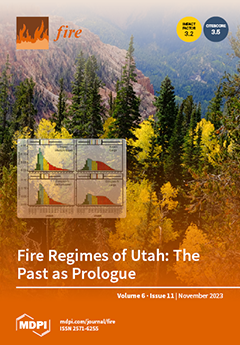Street trees provide ecosystem services such as heat mitigation, improved community well-being, and biodiversity conservation. At the wildland–urban interface (WUI), high-flammability street trees also provide a conflicting ecosystem disservice, heightening risks of wildfire spread into urban areas. We addressed this service–disservice conflict by
[...] Read more.
Street trees provide ecosystem services such as heat mitigation, improved community well-being, and biodiversity conservation. At the wildland–urban interface (WUI), high-flammability street trees also provide a conflicting ecosystem disservice, heightening risks of wildfire spread into urban areas. We addressed this service–disservice conflict by assessing shoot flammability patterns in 10 street tree species, to identify low-flammability species that can potentially mitigate wildfire risks at the WUI. We found significant differences among species in flammability attributes including time-to-flame (TTF), flame duration (FD), number of flaming events (nF), and flame temperature (FT), and identified low-flammability species for each attribute. Overall, species’ rankings from least to most flammable differed considerably across the four attributes. For example, native water gum (
Tristaniopsis laurina) had the slowest TTF, but had the longest FD. Among nine shoot traits, we found that high leafing intensity was the most frequent trait correlated with flammability. In particular, high leafing intensity was significantly related to fast TTF and high FT. Lack of coordination among flammability attributes suggests that, in general, selection of low-flammability street tree species should consider how each flammability attribute differentially contributes to wildfire spread risk. Nonetheless, native Tuckeroo (
Cupaniopsis anacardioides) emerged as a potential candidate for further exploration as a low-flammability street tree as it had comparatively long TTF, short FD, and low nF. We found no consistent evidence that exotic species were less flammable than native species, and suggest that native trees be the focus of further research to identify low-flammability street trees.
Full article





